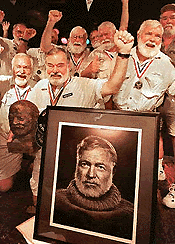The FLORIDA KEYS: The Seven Mile Bridge.

The Seven Mile Bridge, in the Florida Keys, runs over a channel between the Gulf of Mexico and the Florida Strait, connecting Key Vaca (the location of the city of Marathon, Florida) in the Middle Keys to Little Duck Key in the Lower Keys. Among the longest bridges in existence when it was built, it is one of the many bridges on US 1 in the Keys, where the road is called the Overseas Highway.
There are two bridges in this location. The older bridge, originally known as the Pigeon Key-Moser Channel-Pacet Channel Bridge, was constructed from 1909-1912 under the direction of Henry Flagler as part of the Florida East Coast Railway's Key West Extension, also known as the Overseas Railroad.
This bridge was badly damaged by the Labor Day Hurricane of 1935, and subsequently refurbished by the United States Federal Government as an automobile highway bridge. It had a swing span that opened to allow passage of boat traffic, near where the bridge crosses Pigeon Key, a small island where a work camp for Flagler's railroad was located. Hurricane Donna in 1960 caused further damage.
The present road bridge was constructed from 1979 to 1982. The vast majority of the original bridge still exists, used as fishing piers and access to Pigeon Key, but the swing span over the Moser Channel of the Intracoastal Waterway has been removed.
The new bridge is a box-girder structure built from precast, prestressed concrete sections, comprising 440 spans. Near the center, the bridge rises in an arc to provide 65-foot-high clearance for boat passage. The remainder of the bridge is considerably closer to the water surface. The new bridge does not cross Pigeon Key.
The total length of the bridge is actually 35,862 ft or 6.79 miles (10.93 km).
The spectacular bridge has attracted many film makers. Its film 'credits' include scenes in True Lies, 2 Fast 2 Furious, Licence to Kill and Up Close & Personal. In True Lies, filmed in the early 1990s, a section of the old bridge is shown being destroyed by missile strikes. The missiles were edited in, and the explosions were done on an 80-foot (24 m) model of the bridge, but filming was done on the actual bridge, and the "destroyed" section is the former swing span, which had been removed upon completion of the new bridge.
Each April the bridge is closed for approximately 2.5 hours on a Saturday and a "fun run" of 1,500 runners is held commemorating the Florida Keys bridge rebuilding project.


















